Jour de l'indépendance 4 juillet 1943
 |
| Ajouter une légendenotre riviére |
Les forteresses volantes des B-17 ont été abattues dans notre région et le sort de leurs équipages aériens .
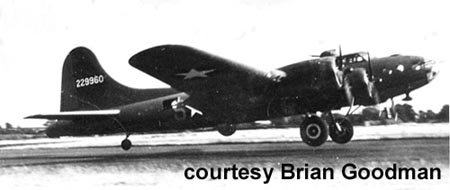 |
B-17F 42-29960 "Nymokymi"
in June 1943.
|
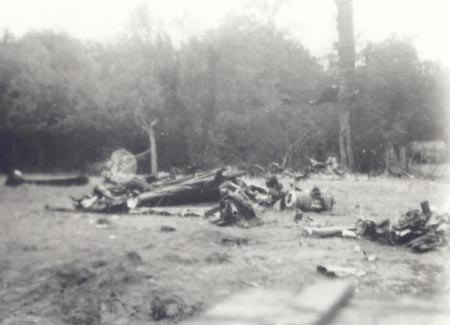 |
The wreck of "Nymokymi" in Belfonds. These are the only existing photos of the wreckage taken by Roger Cornevin, July 5 in the
morning.
|
Near
Le Mans German flak targets and hits a first fortress. In the distance a
swarm of German fighters are getting ready to attack. . .
The right outside engine of the fortress "Nymokimi" of
Lieutenant Gordon Erikson has just been hit broadside by flak and the
propeller is feathered. The plane is distress, trailing a long wake of
black smoke, reaches the small episcopal town of Sees as the formation
is flying back to England.
It is noon. The parishioners are walking out of the cathedral. The
Ormeaux Stadium field, usually occupied by the Werhmacht, is vacant
today for the local and regional athletic teams. Everyone is watching
the fortress desperately trying to reach Grafton Underwood, North of
Bedford, the most Western base in East Anglia she had left from two
hours earliers, but it is no longer possible. . . The pilot Gordon
Erickson stated later: "with one engine disabled, we were
trailing behind the formation heading North. The German fighters, on the
lookout, rush towards our now disabled and isolated aircraft. The oxygen
circuits which allows us to fly at more than ten thousand feet are
destroyed by a murderous enemy fire. I give order to bail out. On board
the fire is raging and the crew rush to the emergency exits. We have
great difficullties opening the evacuation traps. . . My overalls catch
fire and I try to put it out with my hands. As a last resource I go to
the emergency exit to the front, and I jump out behind the mechanic.
The icy cold air blowing through the ejection trap finally put out the
flames which were slowly burning my overalls. Below me I see five white
corollas. . ., green pastures. . ., a river and a cathedral in the
distance. I land, unhurt, on this foreign soil, my parachute caught in
the branches of an apple tree. . ., my feet barely touching ground. Some
villagers run toward me to help. . ., I remove my equipment: parachute
and Mae West. Quickly I use my pocket knife to cutt off the straps of my
parachute. I take cover in a double row of hedges and soon three other
members of my crew, burned on their hands and face, join me here".
In fact eight airmen had parachuted on the Belfonds plain in an area
between the hamlet of Conde le Butor and the church of Cleray. Two
airmen had stayed aboard: bombardier Donald Irvine fell with what was
left of the machine-gun turret at a site called "Chene
d'amour" (oak of love) near Belfonds, and navigator Francis
Hackley, his parachute in flames, fell at "Val d'enfer" (vale
of hell).
Two crewmembers did not escape capture in spite of the quick
intervention of the townsfolks and members of the local resistance,
among which were Edouard Paysant, Departmental Chief of the BOA and
Victor Chevreuil, Mayor of Mortree. The six survivors, comrades of
misfortune, will split into two groups; Lt pilot Gordon Erickson and
three crewmembers will be sheltered in a barn near the village of
Belfonds. The two wounded men, Willard Freeman and Charles Mankowick
will be taken on stretchers by the local Resistance first to a shelter
and then to the Forest of Gouffern near Aunou le Faucon. A hut made of
branches, hidden deep into the forest, will be their shelter for three
weeks during which they receive the necessary care. "our hut was
not very watertight but it was sufficient to shelter us in August. Two
doctors came by regularly to check on the progress of our recovery"
Freeman stated later.
Six months later, after spending a few nights under the stars, followed
by a long stay in the Lyon region to regain some strength, our two
convalescents will reach England and their respective base in December
1943. Gordon Erickson, accompanied by Sargeants Ashworth, Penly, and
Wingerter, will attain Gilbraltar at the end of August 1943 after an
eventful journey, crossing Basque country without any major problem
except for a scary moment in Dax caused by the inquisitive look of a
German agent puzzled by the shoes our travelers are wearing. Alarming
suspicion which worries our evadees and make them fear the worse. Will
their false identity papers stand up to close scrutiny?
After a long dialogue with the agent, their experienced guide finally
get them out of this delicate situation.
At last our evadees cross the border in a truck carrying. . . baby
chicks. Soon after, they reach Bilbao and finally freedom at the British
Consulate here. After the crossing of the Pyrenees and their arrival to
Gibraltar where they are taken in charge by the RAF, our two wounded men,
Freeman and Mankowick, now fully recovered, announce their safe arrival
as soon as they reach London by transmitting the following message on
the BBC: "the friends of the little forest have arrived safely".
What a relief for all the resistants and their helpers in the Sees,
Montree and Argentan region, who had worked to ensure their evasion, at
the risk of their own lives.
Other infos on this crash:
http://www.384thbombgroup.com/pages/erickson.html
|
|
Willard Freeman
|
Gordon
Erickson
|
| (Collection
Didier Cornevin) |
(Collection
Didier Cornevin) |
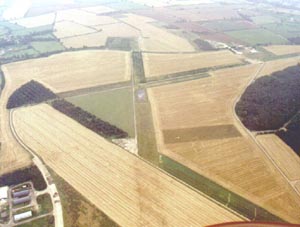 |
Grafton Underwood,
Airfield of the 384 BomberGroups, today.
|
On
the same day and at the same hour, the village of La Coulonche North of
Juvigny-sous-Andaine witnesses a similar drama. The flying fortress
flown by Lieutenants Olaf Ballinger and John Carah suffers the same
fate, crashing at "Val de Vee" in the Andaine Forest. John
Carah: "I had not realized that we did not have any more oxygen
and that the two tail gunners had been killed during the attack by the
German fighters. The elevator jammed and it was impossible to pilot the
plane. I jumped out, remembering the massacre in Antwerp when the
parachutists had been taken for targets by the German fighters. At the
emergency door was Llieutenant Williams, his unfolded parachute in his
arms. . . I told him to jump no matter what. . . but he refused. Huge
emotion! While coming down, a fighter feigning an attack swooped down on
me and scared me to death. . . Then I saw our flying fortress get into a
spin while I desperately scrutinized the ground below to finally spot an
apple orchard. I barely managed to avoid the fork of a tree. I remained
in hiding in the woods for seven hours while observing the surroundings
and the comings and goings at a farm before taking the risk of showing
myself to the farmer. A carafe containing a clear liquid caught my
attention. . . Thirsty, I gulped a glass of calvados. . . I had mistaken
for water.".
L’équipage avait perdu trois de ses membres: les deux mitrailleurs tués en vol et le Lt Williams qui, désespéré, décida de sauter ... trop près du sol. Pourquoi at-il attendu si longtemps? Se souvenant de l’avoir vu sauter. John Carah se demande encore pourquoi de la trappe frontale à la dernière minute avant l’explosion au sol.
Deux membres d'équipage ont été faits prisonniers puis emmenés au "Stalag Luft" réservé aux aviateurs alliés. Prise en charge par un jeune guide et aidée par un réseau de résistance organisé, John Carah partira pour la Suisse après avoir été hébergé près de Lassay, en Mayenne, par la famille Breteau. Fourni avec une fausse carte d'identité au nom de. . . Jacques Dupont, représentant commercial, prend avec ses compagnons tous les moyens de transport disponibles en cours de route. . . train, bus, camion du camp de la jeunesse Pétain, auto-stop. Finalement, c'est une randonnée à pied à travers les forêts de pins, poursuivie par des chiens de patrouille qui gardent la frontière. Notre petit groupe,s'offrir le luxe d'un chauffeur de taxi sympathique atteindra incognito à Berne via le rivage verdoyant du lac de Neuchâtel. Le séjour de John Carah en Suisse, dans une relative liberté, ne pouvait durer très longtemps. Il prend le risque de quitter la neutralité suisse et tente une nouvelle fois de traverser la frontière. . . à la France occupée. . . Incarcérés avec ses compagnons de voyage par la Gestapo, ils sont libérés, sans avoir à se battre, par la Résistance locale après un échange de tirs nourri. John atteint l'Espagne totalement épuisé après la difficile traversée des Pyrénées. Enfin, il perçoit de loin les lumières de Figueras!Il prend le risque de quitter la neutralité suisse et tente une nouvelle fois de traverser la frontière. . . à la France occupée. . . Incarcérés avec ses compagnons de voyage par la Gestapo, ils sont libérés, sans avoir à se battre, par la Résistance locale après un échange de tirs nourri. John atteint l'Espagne totalement épuisé après la difficile traversée des Pyrénées. Enfin, il perçoit de loin les lumières de Figueras!Il prend le risque de quitter la neutralité suisse et tente une nouvelle fois de traverser la frontière. . . à la France occupée. . . Incarcérés avec ses compagnons de voyage par la Gestapo, ils sont libérés, sans avoir à se battre, par la Résistance locale après un échange de tirs nourri. John atteint l'Espagne totalement épuisé après la difficile traversée des Pyrénées. Enfin, il perçoit de loin les lumières de Figueras!John atteint l'Espagne totalement épuisé après la difficile traversée des Pyrénées. Enfin, il perçoit de loin les lumières de Figueras!John atteint l'Espagne totalement épuisé après la difficile traversée des Pyrénées. Enfin, il perçoit de loin les lumières de Figueras!
Nous apportons l'attention sur une dernière pensée dans le témoignage de ce pilote assisté de volontaires et de membres de la Résistance: " Je saisis cette occasion pour exprimer toute mon admiration et ma gratitude aux différentes lignes de la Résistance française. Chaque heure de la journée, elles risquent leur vie de sorte qu'un grand nombre d'aviateurs abattus puissent retourner au combat et ainsi peut-être raccourcir la durée de la guerre ".
Une autre épopée liée à cet accident à La Coulonche est celle du pilote Olaf Ballinger. Épuisé et à la traîne, il est incapable de suivre le même rythme que ses compagnons de voyage. Ainsi, il échappera à peine à leur destin quand ils seront pris dans une embuscade. À l'aube pâle, illuminant les contreforts des Pyrénées, épuisés et ses vêtements en lambeaux, il atteint les premières maisons de la région d'Andorre. Soutenu par la volonté d'atteindre son objectif à tout prix, il prend un repos nécessaire dans un village qui semble ne pas être impliqué dans les tourments de la guerre. Il affrontera les premiers cols à la suite d'un groupe de passeurs portant des ballots de tabac. Puis, après une captivité temporaire dans une prison de Manressa, il atteint le consulat britannique et finalement Gibraltar le 4 décembre.exactement cinq mois après l'accident de La Coulonche.
|
|
|
de gauche à droite: McConnell, navigateur; Bollinger, pilote; Williams, le parachute s'est ouvert dans l'avion; John Carah, copilote.
|
Credited
with having shot down one enemy fighter, Paul McConnell is helped by a
forester in the Andaine Forest. He spends a few days in hiding at the
"Ermitage", a manor situated North of Juvigny -sous-Andaine
and then he is taken in charge by Andre Rougeyron. It is at this time
that he is reunited - unexpectedly - with another crash survivor,
William Howell. Young machine gunner Howell, hastily dressed as a
boy-scout, sporting a Basque beret and carrying a basketful of
vegetables for the sake of the cause, arrived at the "Chalet du
Brouillard" (Andre Rougeyron's home in Domfront) in a horse drawn
carriage. With the help of some Calvados, he endures without complaints
the extraction of schrapnells from his back.
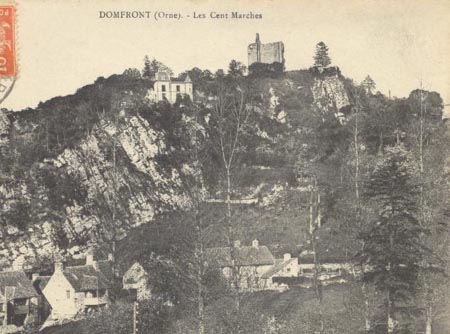 |
"The chalet of fog" in top where many aviators was hidden by André Rougeyron in the public garden of Domfront.
|
An
opportunity will come up for Paul McConnell and William Howell to try an
escape with the Brittany line. But the plan organized in Quimper by the
local Resistance, in coordination with a speed motorboat and a British
submarine off the coast of Ouessant will not succeed. The radio operator
in charge of communications with England had been identified and killed.
However, they will have to make the best of it and return to Paris to
wait for a second opportunity. Reluctantly Paul McConnell and William
will part company. Howell will go on to Perpignan where he is taken in
charge by some unscrupulous guides who will make him and his evadee
companions go round in circles near the border. After the Christmas
holiday it is at last the successful crossing of the Pyrenees, then on
to Gerona, Barcelone, Madrid, and finally Gibraltar in February 1944,
seven months from the date of the crash in La Coulonche.
In desperation, the Resistance decides to turn over the navigator Paul
McConnell* to the "Comete" line an organization where, for
each escape, one courageous patriot would pay with his life. Train to
Pau, a stop at a Basque farmhouse, frequent change of guides, a long
march without respite in the bitter cold before reaching, exhausted, a
Spanish farm. Then a stay in a jail where some thirty prisoners evadees
- crash survivors and German deserters - are awaiting for the Spanish
authorities to decide of their fate. At last it is the much awaited
welcome of the United States Embassy, then Gibraltar, and finally one
last stop,Scotland, and the return to the United States on March 1,
1944, that is an eight month journey since the crash in La Coulonche.
|
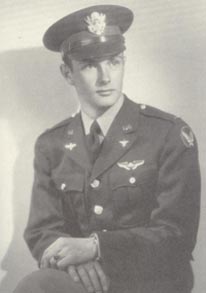 |
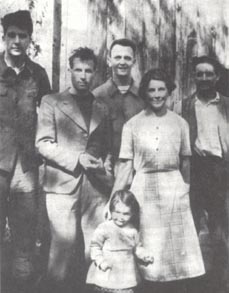 |
|
McConnell,
navigator
|
Owens,
Bollinger (center) and the family who hid them. |
Owens,
Gunner.
|
Machine-gunner
Owens, another miraculous survivor of the crash at Val-de-Vee,
would not escape destiny. After being sheltered by Geslain, a
farmer in St Opportune, he accompanies Ballinger and his group
part of the way on their journey. His body will be found in the
mountains and the cause of his death will remain a mystery.
There are various explanations . . . he was killed by a border
while crossing the foothills of the Pyrenees or he died from
exposure to the elements.
|
|
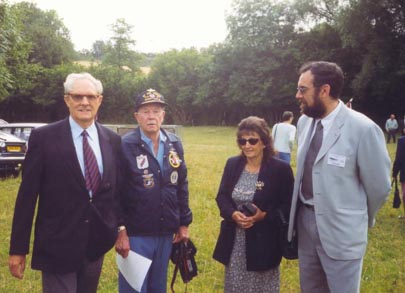 |
Paul
McConnell, in leather jacket and John Carah,
with the blue cap, at the time of the ceremony of Belfonds in 1999
|
|
During
this same raid, at the same hour, two other flying fortresses were shot
down in the Sarthe region, West of Le Mans. Machine-gunner David Butcher
will be the only surviving crew member. His fortress
"Lakanuki" is hit by flak and explodes in flight. Panic. . .
surviving instinct. . . almost unconscious, he finds himself,
miraculously, parachute opened, above the village of Poille sur Vegre.
"What a bizarre feeling!" he will say later. Two providential
villagers help him slip away. . . by bicycle. Clandestinely employed as
a "deaf and mute" gardener and later on unwillingly draftet in
the local Resistance network, he takes part in receiving the arms
parachuted by planes supplying the maquis. His adventurous journey in
French territory willl have lasted seven months. His companions in the
Resistance will have suffered various fortunes but David Butcher, lucky
in spite of himself, thwarted all the ambushes set on the way. He kept
undying memories of his stay on French territory . Today he is honorary
citizen of Poille sur Vegre.
|
|
|
|
Alfred
Auduc, chief of the local
Resistance and belonging to the "reseau Buckmaster" .
|
David
Butcher, alone
survivor of the crash of the Fortress "Lakanuki" and Alfred
Auduc. |
Noon
and the twelve strikes of the town clock chime in the quiet countryside
of Noyen Malicorne Maezeray area. The inhabitants go about their work. A
fourth fortress, the "Mugger", hit by flak, crashes. A witness
notices in the distance "the parachutists coming down and trying to
avoid the areas in flames on the ground". The fire spreads. All are
fighting the blaze: the Werhmacht, the gendarmes, the firemen, and the
townsfolk. . .
One
of the airmen lands on the roof of a hangar, another near a German
encampment. The latter will relate: "I had landed in a wheatfield
just harvested. No way to hide. I noticed a wooded area nearby. I heard
gunfire and saw two German soldiers running toward me gun in hand. I had
suffered serious burns on my hands and face. . . and I was bleeding".
Among the ten crew members: two killed, two taken prisoners, and six
evadees who will manage to slip through the net spread by their pursuers.
But once again it is a tragedy heavy with consequences for the
townsfolks among which some, as it happened in our little town of Sees .
will know deportation.
|
Leaving
this very day the airfields of East Anglia sixty other B-17 flying
fortresses are flying in direction of the locks of La Pallice. Four
other fortresses will be shot down by flak and German fighters at the
following points: Island of Oleron (Charente Maritime), La Gueriniere (Vendee),
St Colomban (Loire Atlantique.The following link tells the history of this
fortress:http://perso.wanadoo.fr/giraudeau
) and the Bay of Biscay. A ninth fortress
will make a forced emergency landing upon her return to Great Britain.
Before
rejoining their respective bases in Great Britain, the airmen who have
survived the crash of their plane in our region on this Independence Day
have endured, as many others have, the dangers of aerial combat, the
resulting terrible emotion and lastly. . . the jump into the unknown on
a territory full of traps and pitfalls after having bailed out of their
disabled aircraft. All these dramatic events are generally followed by
an uninterrupted manhunt in the woods, the towns, or the countryside.
It
is often possible to bring together a view of the facts and events, if
one consider the dangers incurred, with the testimonies from the
Resistance members and all the others - patriots, those who gave shelter,
the anonymous volunteer helpers - met by chance in a forest and having
participated in the rescue and life-saving operations at their own risks
and perils.
Roger
Cornevin, Association
Normande du Souvenir Aérien 39-45
Translation by Marie Antoinette McConnell
|
|
|
Localization of the crashs: 1 Belfonds; 2 la
Coulonche; 3 Poillé sur Végre; 4
Malicorne
|
|
|
Roger Cornevin and his brother on the wreckage of a Me 109 shoot by Flying Fortresses, July 4 1943.
|
*
After the failed escape attempt off the Brittany coast, Paul McConnell
returned to Paris where he was sheltered by Resistance members -
Raymonde Chassagne in Paris and Lucienne Fevre in Pavillons-sous-Bois (shortly
after Paul McConnell's escape , Raymonde Chassagne was arrested by the
Gestapo and sent to the concentration camp of Ravensbruck). On December
24, 1943, another escape attempt was aborted when the line had been
infiltrated and most members arrested.
Sources:
Personal letters with the allied aviators, Archives of the Usaaf,
"Agents d'évasion" of André Rougeyron. Cahiers flêchois 1995.
Thank you to ask for the author's authorization for a partial or complete publication of this narration
|
|
|



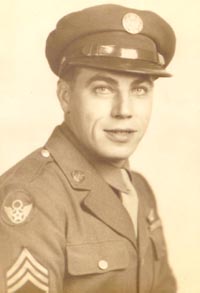
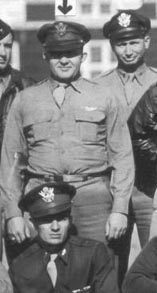

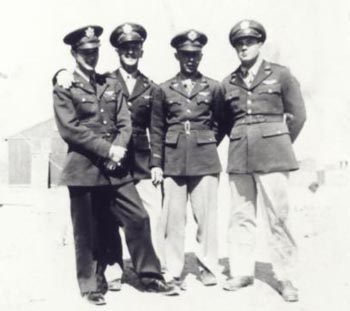



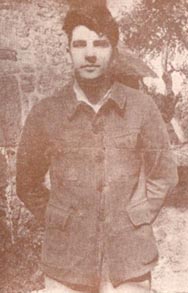
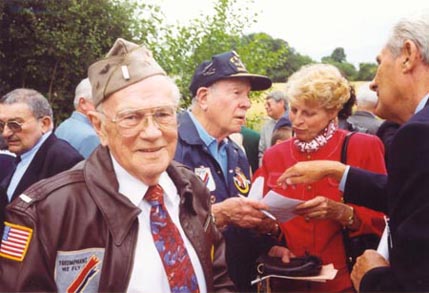

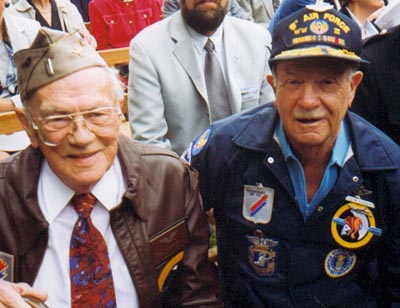
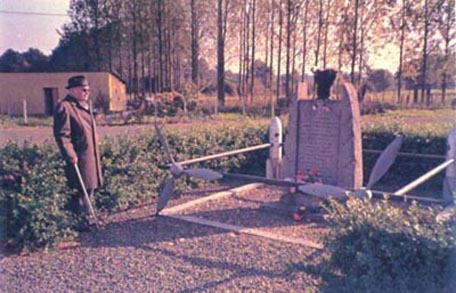
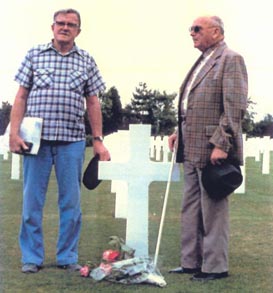
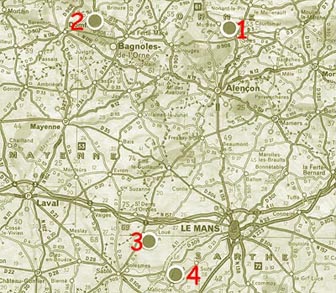
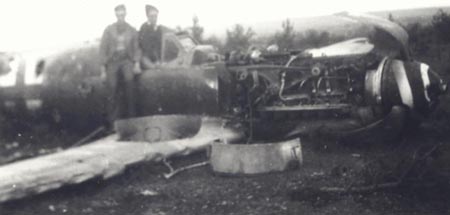


Aucun commentaire:
Enregistrer un commentaire